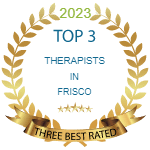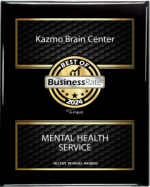What is a Panic Disorder?
Panic disorder occurs when you experience recurring unexpected panic attacks. The DSM-5 defines panic attacks as abrupt surges of intense fear or discomfort that peak within minutes. People with the disorder live in fear of having a panic attack. You may be having a panic attack when you feel sudden, overwhelming terror that has no obvious cause. You may experience physical symptoms, such as a racing heart, breathing difficulties, and sweating.
Most people experience a panic attack once or twice in their lives. The American Psychological Association reports that 1 out of every 75 people might experience a panic disorder. Panic disorder is characterized by persistent fear of having another panic attack after you have experienced at least one month (or more) of persistent concern or worry about additional panic attacks (or their consequences) recurring.
Even though the symptoms of this disorder can be quite overwhelming and frightening, they can be managed and improved with treatment. Seeking treatment is the most important part of reducing symptoms and improving your quality of life.
Whereas anxiety is a normal emotion. It’s your brain’s way of reacting to stress and alerting you of potential danger ahead.
Everyone feels anxious now and then. For example, you may worry when faced with a problem at work, before taking a test, or before making an important decision.
Occasional anxiety is OK. But anxiety disorders are different. They’re a group of mental illnesses that cause constant and overwhelming anxiety and fear. The excessive anxiety can make you avoid work, school, family get-togethers and other social situations that might trigger or worsen your symptoms.
What are The Symptoms of Panic Disorder?
Symptoms of panic disorder often begin to appear in teens and young adults under the age of 25. If you have had four or more panic attacks, or you live in fear of having another panic attack after experiencing one, you may have a panic disorder.
Panic attacks produce intense fear that begins suddenly, often with no warning. An attack typically lasts for 10 to 20 minutes, but in extreme cases, symptoms may last for more than an hour. The experience is different for everyone, and symptoms often vary.
Common symptoms associated with a panic attack include:
- Racing heartbeat or palpitations
- Shortness of breath
- Feeling like you are choking
- Dizziness (vertigo)
- Lightheadedness
- Nausea
- Sweating or chills
- Shaking or trembling
- Changes in mental state, including a feeling of derealization (feeling of unreality) or depersonalization (being detached from oneself).
- Numbness or tingling in your hands or feet
- Chest pain or tightness
- Fear that you might die
The symptoms of a panic attack often occur for no clear reason. Typically, the symptoms are not proportionate to the level of danger that exists in the environment. Because these attacks can’t be predicted, they can significantly affect your functioning.
Fear of a panic attack or recalling a panic attack can result in another attack.
Anxiety Disorder Symptoms
The main symptom of anxiety disorders is excessive fear or worry. Anxiety disorders can also make it hard to breathe, sleep, stay still and concentrate. Your specific symptoms depend on the type of anxiety disorder you have.
Common symptoms are:
- Panic, fear, and uneasiness
- Feelings of panic, doom or danger
- Sleep problems.
- Not being able to stay calm and still
- Cold, sweaty, numb or tingling hands or feet
- Shortness of breath
- Breathing faster and more quickly than normal (hyperventilation)
- Heart palpitations
- Dry mouth
- Nausea
- Tense muscles
- Dizziness
- Thinking about a problem over and over again and unable to stop (rumination)
- Inability to concentrate
- Intensely or obsessively avoiding feared objects or places
What Causes Panic Disorder?
The causes of panic disorder are not clearly understood. Research has shown that panic disorder may be genetically linked. Panic disorder is also associated with significant transitions that occur in life. Leaving for college, getting married or having your first child are all major life transitions that may create stress and lead to the development of panic disorder.
Causes of Anxiety Disorder
Some causes of anxiety disorders are:
- Genetics. Anxiety disorders can run in families.
- Brain chemistry. Some research suggests anxiety disorders may be linked to faulty circuits in the brain that control fear and emotions.
- Environmental stress. This refers to stressful events you have seen or lived through. Life events often linked to anxiety disorders include childhood abuse and neglect, a death of a loved one, or being attacked or seeing violence.
- Drug withdrawal or misuse. Certain drugs may be used to hide or decrease certain anxiety symptoms. Anxiety disorder often goes hand in hand with alcohol and substance use.
- Medical conditions. Some heart, lung, and thyroid conditions can cause symptoms similar to anxiety disorders or make anxiety symptoms worse. It’s important to get a full physical exam to rule out other medical conditions when talking to your doctor about anxiety.
Risk Factors for Anxiety Disorders Include:
- History of mental health disorder. Having another mental health disorder, like depression, raises your risk for anxiety disorder.
- Childhood sexual abuse. Emotional, physical, and sexual abuse or neglect during childhood is linked to anxiety disorders later in life.
- Trauma. Living through a traumatic event increases the risk of posttraumatic stress disorder (PTSD), which can cause panic attacks.
- Negative life events. Stressful or negative life events, like losing a parent in early childhood, increase your risk for anxiety disorder.
- Severe illness or chronic health condition. Constant worry about your health or the health of a loved one, or caring for someone who is sick, can cause you to feel overwhelmed and anxious.
- Substance abuse. The use of alcohol and illegal drugs makes you more likely to get an anxiety disorder. Some people also use these substances to hide or ease anxiety symptoms.
- Being shy as a child. Shyness and withdrawal from unfamiliar people and places during childhood is linked to social anxiety in teens and adults.
- Low self-esteem. Negative perceptions about yourself may lead to social anxiety disorder.
How is Panic Disorder Treated?
Treatment for panic disorder focuses on reducing or eliminating your symptoms. This is achieved through therapy with a qualified professional and in some cases, medication. Therapy typically involves cognitive-behavioral therapy (CBT). This therapy teaches you to change your thoughts and actions so that you can understand your attacks and manage your fear.
Medications used to treat panic disorder can include selective serotonin reuptake inhibitors (SSRIs), a class of antidepressant. SSRIs prescribed for panic disorder may include:
- Fluoxetine
- Paroxetine
- Sertraline
Other medications sometimes used to treat panic disorder include:
- Serotonin-norepinephrine reuptake inhibitors (SNRIs), another class of antidepressant
- Anti-seizure drugs
- Benzodiazepines (commonly used as tranquilizers)
- Monoamine oxidase inhibitors (MAOIs), another type of antidepressant that is used infrequently because of rare but serious side effects.
In addition to these treatments, there are a number of steps that you can take at home to reduce your symptoms. Examples include:
- Maintaining a regular schedule
- Exercising on a regular basis
- Getting enough sleep
- Avoiding the use of stimulants such as caffeine
While treatments for anxiety disorder include:
Medication . Several types of drugs are used to treat anxiety disorders. Talk to your doctor or psychiatrist about the pros and cons of each medicine to decide which one is best for you.
Antidepressants. Modern antidepressants (SSRIs and SNRIs) are typically the first drugs prescribed to someone with an anxiety disorder. Examples of SSRIs are Escitalopram (Lexapro), and Fluoxetine (Prozac). SNRIs may include Duloxetine (Cymbalta), and Venlafaxine (Effexor).
Bupropion. This is another type of antidepressant commonly used to treat chronic anxiety. It works differently than SSRIs and SNRIs.
Other antidepressants. These include tricyclics and monoamine oxidase inhibitors (MAOIs). They are less commonly used because of side effects, like drops in blood pressure, dry mouth, blurry vision and urinary retention, and can be unpleasant or unsafe for some people.
Benzodiazepines. Your doctor may prescribe one of these drugs if you’re having persistent panicky feelings or anxiety. They help lower anxiety. Examples are Alprazolam (Xanax), and Clonazepam (Klonopin). They work quickly, but you can become dependent on them. Usually, they’re meant to be an add-on to your anxiety disorder treatment and you shouldn’t take them for a long time.
Beta-blockers. This type of high blood pressure drug can help you feel better if you’re having physical symptoms of anxiety, such as a racing heart, trembling or shaking. A beta-blocker may help you relax during an acute anxiety attack.
Anticonvulsants. Used to prevent seizures in people with epilepsy, these drugs also can relieve certain anxiety disorder symptoms.
Antipsychotics. Low doses of these drugs can be added to help make other treatments work better.
Buspirone (BuSpar). This anti-anxiety drug is sometimes used to treat chronic anxiety. You’ll need to take it for a few weeks before seeing full symptom relief.
The above information is for reference purposes only, and shall not be construed as recommendation. Indeed, before taking any medications you need to consult with your psychiatrist or physician for through evaluation.
Kazmo Brain Center is a counseling center in Frisco, Texas specializing in mental health counseling and will work with you toward a happier and more satisfying position. If you or your loved ones need help, Request an appointment at the Kazmo Brain Center and we are here to help.







